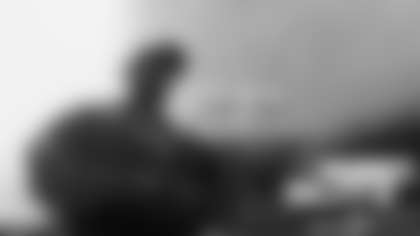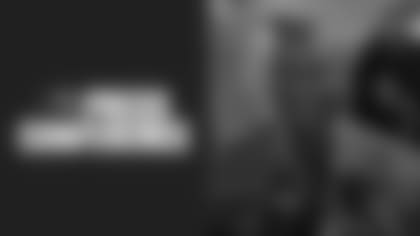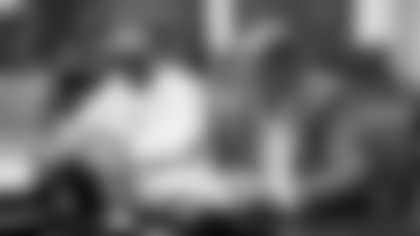If you're keeping track, you know that the Answer Man last posted a column on December 6, making the subsequent five-and-a-half weeks until today the longest drought since my debut in August of 2004. Obviously, this site was focusing on the nuts and bolts of the Buccaneers' exciting playoff chase, and I was a bit busy with such menial tasks as lugging around boxes of NFC South Champion hats. My Bucs.com gig aside, I am still primarily a beast of burden around here, thanks to my superhuman strength.
Nevertheless, when the offseason hit prematurely and I dug back into my waiting e-mailbag, I already knew what I was going to find.
To be fair, there was a good mix of questions in the bag, as always, and you'll see some of the results below. But there was one topic that I knew would be first and foremost on the minds of Buc fans. I'll bet you can guess, too.
The catch. Or the non-catch. The touchdown that wasn't, or whatever you want to call it. When Edell Shepherd hauled in a potential game-tying touchdown catch against Washington in the Wild Card playoff game, only to have the ball slide under him for a moment when he hit the ground in the end zone, it became an unforgettable moment in franchise history. That play, we all know, will be recalled and debated for years, just as the Bert Emanuel catch/non-catch in the 1999 NFC Championship Game has been.
Amazingly, however, there were questions on the rules surrounding the Shepherd ruling in my mailbag even before the Wild Card game, thanks to a very similar play by Atlanta's Roddy White in the Christmas Eve game. In a more curious and less furious way, fans sought clarification on the rule in the days after that game, not knowing how critical it would be to the Bucs' season in the end. And to the end of the Bucs' season.
Of course, there were also many letters of more recent vintage on the topic, some disagreeing with the Shepherd ruling or asking for clarification. I didn't use any of them here because I think the topic has been discussed at great length already, on this site and elsewhere. Let's go ahead and summarize the situation and the ruling here, though, just to get everybody on the same page.
When a player makes a catch at any point during the game, one of the criteria he must meet for that catch to count is this: If he is falling to the ground in the act of making the catch, he must hold on to the ball when he hits the ground, no matter where he is on the field or out of bounds and how many feet he got down after catching the ball. Shepherd's play was ruled thusly: He caught the pass, took two steps in the end zone as he was being tackled and fell to the ground, landing first on his knee. He then fell forward, and when his torso hit the ground, the ball came out of his hands and slid along the turf before he collected it back into his grasp. No catch.
At least, that was the judgment of the officials. One can't really argue with the rule; to disagree, one would have to argue that the judgment of whether or not Shepherd held onto the ball until he was down was accurate. As with any such ruling, we are free to disagree. Nevertheless, the rule that was applied is clear: If the receiver is in the act of falling as he makes a catch, he must hold onto the ball when he hits the ground, no matter where that is.
Hopefully, we are all clear on that rule now, though we certainly don't like the manner in which our education was delivered. However, there are several points of clarification I think are worth discussing that were prompted by e-mails sent in before the Shepherd play. Let's take a quick look.
First, Jay from Saint Petersburg, Florida asks:
1. Please explain the difference between a catch in the field of play and a catch in the end zone. When I was at the Falcons game yesterday (12/25), that Atlanta pass in the 4th quarter looked like a touchdown to me. Don't get me wrong, I was elated when it was confirmed as an incomplete pass. It was just a little puzzling to me. Thanks, Jay.
Answer Man: The answer, Jay, is that there is no difference. None at all.
Don't worry if that doesn't seem clear. I think it's safe to say that this is one of the most common misconceptions about this rule.
The plays by Roddy White and Edell Shepherd would have been ruled the same way if they had occurred at midfield, or if they had occurred with the receiver dragging his toes while going out of bounds at the 25.
The key here is establishing possession of the ball. On a reception, that means you have to catch it, get two feet or a knee or your torso on the ground inbounds and hold onto the ball when you hit the ground if you're falling as you catch it. Had Shepherd done the exact same thing he did while catching a ball at the midfield stripe, it still would have been ruled no catch.
It's the end zone, in fact, that confuses this rule. It seems to appeal to our football common sense (and I include myself in this) that a player who catches the ball and then puts two feet in the end zone should have a touchdown right there, play over. And that's true if the player is standing as he makes the catch and not falling, or being forced to fall by a tackler. If Shepherd were standing in the middle of the end zone and Chris Simms hit him with a pass, and he caught it cleanly and stood on his two feet, that would be a touchdown. If, a beat later, a tackler came along and knocked Shepherd down, in turn knocking the ball loose, it wouldn't matter because the play would be over.
The confusion comes from our knowledge that a runner who puts the ball over the goal line has scored a touchdown, no matter what happens in the next instant. If Mike Alstott takes a handoff and dives over the goal line with the ball extended, only to have it slapped out of his hand immediately afterward, that would be ruled a touchdown and not a fumble. The moment the ball touched the goal line or the vertical plane extending upward from the goal line, it's a touchdown and a dead ball.
The difference is, the runner in this case already has possession of the ball. With the ball already established in his possession, Alstott puts it into the end zone. A receiver who is in the end zone trying to catch a pass must establish that possession before the fact that he's in the end zone makes it a touchdown. Shepherd never officially established possession because one of the things he had to do was hold onto the ball as he hit the ground; at least, that was the judgment of the officials.
Okay, next we have a question that really refers more directly to the Emanuel situation, though its clarifications can help us here. It comes from Kraig of Grand Rapids, Michigan, who asks:
2. While watching the Green Bay/Chicago game, I saw a play in which a receiver was falling as he caught the ball. I know the receiver must maintain control of the ball through the entire fall in this situation (and he did) but the nose of the ball also touched the ground. It was ruled a completion and the replay judge (since it happened w/ under 2 minutes) did not call for a replay. I got into a debate with my siblings (what better reason to get back together on Christmas than to argue sports) on whether the ball is allowed to hit the ground. They claimed the ball could touch the ground as long as you had it in your control beforehand. I claimed that if you are falling not only do you have to maintain control of the ball through the fall, but the ball cannot touch the ground either. I ended up conceding that I "could" be wrong, but vowed further research. Please help me out. Hopefully being on a Bucs site they will never find this if I am wrong. :-)
Answer Man: You are saved, Kraig, by the fact that your siblings are apparently not Buccaneer fans. They are, however, correct, and the most famous example of why they are correct dates back to that 1999 NFC Championship Game.
In that game, the Bucs were trailing 11-6 with one minute to play when Shaun King appeared to hit Emanuel with a completion of 12 yards down to the St. Louis 23. Emanuel dived to make the catch, landing prone on his stomach, and the Bucs called their final timeout, thinking they were facing a third-and-11 at the 23 with 47 seconds left.
However, replay officials in the booth upstairs overturned the catch during the break. They ruled that it was an incompletion because the ball hit the ground as Emanuel landed. Two desperate passes later, the Bucs' 1999 Super Bowl dreams were over.
Ah, but after the game the NFL admitted that, under an existing rule, the catch should have stood. What happened in Emanuel's case is that he had the ball firmly grasped in both hands as he hit the ground with his arms stretched out in front of him. The ball, still firmly in his hands, made contact with the ground but did not move within his hands. As the rule states, the ball can touch the ground while in a receiver's possession; it only becomes an incompletion if that contact causes the receiver to lose his grip on the ball. Had it slid in his hands, even just a little, it would have been accurately called an incompletion.
The following offseason, the NFL made a point of clarifying that rule, and it came to be known informally as the Bert Emanuel Rule, even though it was already in place that day and was not applied correctly to Emanuel's case.
That satisfies Kraig's question (and mostly satisfies his siblings if they ever get to read this). Here's how it applies, if even just a little, to the Shepherd situation. Had the same thing happened and Shepherd merely rolled over the ball when his torso hit the ground, allowing it to touch the ground but not move within his hands, it would have been ruled a catch.
Okay, that's enough on the Shepherd play and the Washington game for now. I have no doubt we'll be talking about it in future columns, but for now let's move on to a greater variety of topics.
**
- Mike Zuydam of Sydney, Australia asks:
I noticed that John Lynch has an entry in the Rushing list, 1 carry for 40 yards. I don't remember this and while I have been a fan for 30 years in Australia we do not get coverage of anywhere near enough games. Can you give me some details of this play and game. I'm guessing it was a reverse but why was John on the field?
Answer Man: You mean John Lynch, the Bucs' all-time leader in yards per carry? If you set no minimum limit on the number of carries, then Lynch's 40 yards per tote is easily the best in team history, doubling the average of that noted ballcarrier, Michael Husted (one carry for 20 yards).
No, Mike, that play was not a reverse. As you note, it would be strange (though not illegal) to have Lynch on the field for an offensive play, and probably a dead giveaway, too. No, that play was a fake punt.
The date was September 22, 1996 and the opponent was Seattle. It was the fourth game of Tony Dungy's first season at the helm of the Buccaneers. The Bucs were locked in a 3-3 tie with Seattle with about five minutes left in the first half. They faced a fourth-and-two at their own 40 and brought on the punting unit.
It was a fake. Back then, Lynch played the "up-back" position on the punting unit; that is, he was the guy you see standing alone between the players on the line and the punter. This position is responsible for calling out the snap and also for picking up any loose rusher that gets past the line.
On this play, the snapper – then, like now, Dave Moore – shot the ball directly into Lynch's hands, while punter Tommy Barnhardt pretended it was sailing over his head. Lynch simply ran right up the middle, past rushers who were still trying to go the other way, towards Barnhardt. Lynch burst free into the open field and, for a moment, looked as if he might even take it the full 60 yards for a touchdown.
Lynch was denied the score, however, by the last player who could stop him, the Seahawks' punt returner. That return man? None other than Joey Galloway. Since Galloway came to the Buccaneers in 2004, Head Coach Jon Gruden has frequently pointed out how deceptively strong and tough the receiver is, and he proved it on this play, in his second season in the league, temporarily saving a touchdown.
Galloway got Lynch down after a 40-yard gain, but the Buccaneers still went on to score on the drive. A third-and-three pass to Karl Williams in the face of a blitz put the ball at the six, and two Reggie Brooks runs took it in from there. That gave the Bucs a 10-3 halftime lead, but they would eventually lose the game, 17-13, when Seattle scored twice in the game's last five minutes.
That was the fourth loss in an 0-5 start under Dungy. However, the team righted itself in the second half, winning six of its last 11 and five of its last seven to finish 6-10. The next year, the Bucs started 5-0 and eventually broke a 15-year playoff drought.
**
- George M. of Richmond, Virginia asks:
What is the biggest point deficit the Bucs have ever overcome to win a game?
Answer Man: That's an excellent question, George, coming as it does on the heels of several comeback victories in the second half of 2005. The difference: those last-minute victories over Washington and Atlanta (twice) were thrilling contests but in none of them were the Bucs ever down by more than seven points.
The double-digit comeback, in contrast, is a relative rarity in Buccaneer annals. The last time Tampa Bay rallied from a deficit of 10 or more points to win a game was December 12, 1999. On that date, the Bucs quickly fell behind Detroit 10-0 but then dominated most of the rest of the game and won 23-16.
Had the Bucs rallied from being down 14-0 against Washington last Saturday – had the ball not slid just a bit when Edell hit the ground - it would have matched the third-largest comeback in team history, and the largest in the postseason, though just barely. On January 15, 2000, the Bucs bought a ticket to the NFC Championship Game by defeating Washington 14-13…after the Redskins had taken a 13-0 lead in the third quarter. Imagine that happening twice to the Redskins in the playoffs in Tampa…alas, all we can do now is imagine.
But I'm beating around the bush here. Your question is the biggest point deficit the Bucs have ever overcome to win a game. The answer: 17.
Great! On to the next question…
What? Oh, you want details? Well, usually I value brevity, but if you insist...
Here are the four largest comebacks in Buccaneer history, as measured by the biggest point deficit the team overcame to win.
| **Deficit** | **Deficit Score** | **Opponent/Location** | **Date** | **Final Score** |
| 17 | 6-23 | vs. Chicago | 1/2/83 | 26-23 (OT) |
| 17 | 0-17 | at Baltimore | 9/9/79 | 29-26 (OT) |
| 14 | 0-14 | at San Diego | 11/17/96 | 25-17 |
| 14 | 0-14 | at Detroit | 9/16/84 | 21-27 |
There are several rather significant games on that list.
The win over Chicago in 1983 – which, by the way, was the final regular-season game of the strike-shortened 1982 campaign and would be the last time the Bucs would beat the Bears for six years – vaulted Tampa Bay into the playoffs.
The players' strike of '82 gouged seven games out of the middle of the schedule. When play resumed, the NFL eliminated the divisions and turned each conference into one big playoff pool, from which the top eight teams on each side were put into the postseason. There were only 14 teams in each conference at the time, so two teams (Cleveland and Detroit) even made the playoffs with 4-5 records, though they didn't last long.
The Bucs' season-ending win over Chicago made them 5-4 and dropped the Bears to 3-6; had Tampa Bay lost the game, they would have been 4-5 and would not have made it into the postseason on tiebreakers. That appeared to be the likely outcome when, with only seven minutes left in the third quarter, the Bucs fell behind 23-6.
Tampa Bay dug a huge hole in that game the way teams usually do: turnovers. Doug Williams' second pass of the game was intercepted and converted quickly into a field goal. In the second quarter, linebacker Otis Wilson returned another interception 39 yards for a touchdown. A Williams fumble on the last play of the first quarter set up another short Chicago field goal.
Williams was red-hot in the second half, however. He threw on every play of a 60-yard touchdown drive in the third quarter, and eventually tossed 29 passes in the second half, finishing with a 367-yard outing. He led a two-minute drill in the fourth quarter that ended in Bill Capece's 40-yard field goal with 26 seconds to play, tying the game and sending it to overtime. The Bucs lost the toss but forced a quick three-and-out, getting the ball back at their own 40. On first down, James Wilder took a pitch around right end and broke free for 47 yards down to the eight. Two plays later, Capece won it with a 33-yarder, sending the Bucs to the playoffs (where they were dispatched, 30-17, by Dallas).
The other 17-point comeback was a big one, too. It was much earlier in the season, but it was part of the Bucs' historic worst-to-first turnaround in 1979 (that phrase is used fairly commonly these days, but it was a very uncommon achievement 25 years ago).
The Baltimore Colts needed only one quarter to build a 17-0 lead over the visiting Buccaneers on September 9, 1979. Of course, that gave Tampa Bay three quarters to rally, and they started with two touchdowns in the second quarter. The Bucs didn't panic, kept running the ball, and Ricky Bell and Jerry Eckwood powered the back-to-back scoring drives.
Tampa Bay actually blasted past the Colts with their own run, scoring 26 unanswered points to take a nine point lead four minutes into the fourth quarter. That's when Baltimore rallied, scoring twice in the game's final seven minutes. Quarterback Greg Landry hit wide receiver Brian DeRoo for a 67-yard touchdown on third-and-13, then Toni Linhart hit a 38-yard field goal with 1:26 to play. The kick only tied the game because Linhart had missed the previous extra point, helping to balance two missed PATs by the Buccaneers (yes, things were a bit different in the NFL in 1979).
Again, the Bucs lost the toss. However, Randy Crowder sacked Landry on the third play of overtime, forcing a fumble that Bill Kollar recovered at the Colts' 14. Neil O'Donoghue ended it with a 31-yard field goal on the next snap.
The biggest comeback that the current generation of Buccaneer fans might remember occurred in San Diego on 11/17/96. Six years and two months later, when the Buccaneers won Super Bowl XXXVII in that same city, most of the team's longstanding veterans pointed to the Chargers game in '96 as the turning point.
The Bucs fell behind 14-0 in that one thanks to, yes, turnovers. San Diego scored on the third play of the game, then got the ball back later in the quarter when Marvin Marshall fumbled on a punt return. A one-play drive put the Bucs deep in the hole, but they managed a field goal a few minutes later and the comeback was on. QB Trent Dilfer had one of his sharpest days as a Buccaneer, hitting 30 of 40 passes for 327 yards and the Bucs had pulled within 17-16 with eight-and-a-half minutes to play. San Diego native John Lynch then intercepted a Stan Humphries pass, setting up Errict Rhett's go-ahead, one-yard touchdown run. The Bucs tacked on a field goal to win by eight and the second half surge of 1996 had its signature game.
Conversely, it's hard to build much historical excitement over the comeback win against Detroit in 1984. That was a forgettable 6-10 season and the Lions were even worse, at 4-11-1. We've come this far, though, so a quick look at the details is in order.
A 77-yard touchdown catch by Mark Nichols in the first quarter was followed by a 47-yard Detroit TD drive after a Jack Thompson interception. After completing just six of his first 13 passes, Thompson was replaced by Steve DeBerg, who immediately led a 67-yard touchdown drive just before halftime. DeBerg also started the second half with a 16-play, 79-yard scoring drive to tie the game. Detroit pulled back ahead on a field goal after a James Wilder fumble, but DeBerg threw a five-yard TD pass to Jimmie Giles in the fourth quarter for the win. DeBerg completed 18 of 27 passes for 195 yards, two TDs and no interceptions in his outstanding relief effort.
You know, George, I almost put your question into the "Quickie" section at the end of this column, but instead I ended up treating it to a 22-paragraph, one-table pummeling. Long-time readers of this column are surely not surprised.
**
- Rob of Orlando, Florida asks:
When it comes to the injured reserve, if a team makes it to the playoffs are they allowed to reactivate the player?
Answer Man: In a word, Rob, no.
Putting a player on injured reserve makes him ineligible to return to action at any point during that season, including the playoffs, at least for your team. If you release a player from injured reserve, he can sign with another team and play again that year.
Thus, if a team thinks it has a chance to get an injured player back in January, it has to make the hard decision of whether or not to put him on injured reserve. Doing so frees up a roster space, which can obviously come in handy, but it erases any chance of the injured player returning. Teams may instead keep that injured player on the 53-man roster and simply make him one of their game-day inactives each week until he is healthy enough to play.
That's what the Eagles did with Terrell Owens in 2004, even though the leg fracture he suffered in Week 15 was thought to possibly be season-ending. Because Owens' prognosis held out the possibility that he could return just in time for the Super Bowl, the Eagles kept him on the active roster and he did indeed play in the big game. He had a big game, too, and that's the last time Owens made any news whatsoever.
**
- Richard Schilling of Bethlehem, Pennsylvania asks:
Answer Man, define the fine line. If a team runs a play on fourth down and fails to make a first down, at what point is possession technically transferred to the other team? More specifically, if the defense commits a penalty AFTER the fourth down play (such as a personal foul), is it always assessed after their offense takes possession, or can it give the team that made the failed attempt yardage for a first down? I suspect the line is at what the officials determine to be the end of the play. If so, would a late hit be considered part of the play? Educate me.
Answer Man: A long layoff by the Answer Man means a good half-dozen long, pithy questions by frequent contributor Rich Schilling in the ol' e-mailbag. This is the one I went with, Rich; sorry if the other ones never make it into the column, though I'm sure I'll be hearing from you again.
I liked this one because it made me think of a couple plays in that Wild Card loss to Washington in a different light.
The first play was in the third quarter, during a Tampa Bay drive that lasted from 5:47 to 1:30. The Bucs faced a third-and-nine at their own 19 when Chris Simms was forced to scramble up the middle and came up six yards short. Tampa Bay was about to send its punting unit onto the field when safety Sean Taylor spit in the face of running back Michael Pittman, with referee Mike Carey fortunately standing right next to the two. Taylor was ejected and the Redskins were hit with a 15-yard penalty, giving the Bucs enough for a first down and prolonging the drive (though it eventually ended in a punt).
The second play was in the fourth quarter, when the Bucs went for it on fourth-and-one at the Washington 19 and threw an incompletion when the Redskins very thoroughly covered an attempted play-action pass to fullback Jameel Cook.
Now, what if we could change history and put Taylor's moment of salivatory indiscretion at the end of that second play, the incomplete pass in Cook's direction, rather than after Simms' scramble? Would the 15 yards give the Bucs a new first down at that point and a shot at the game-tying touchdown that just never materialized?
No, it would not, and the reason is the answer to your very first question, Ricardo. Possession transfers to the other team at the moment the whistle blows to end the unsuccessful fourth down. The clock does stop on the change of possession, but the 25-second play clock will begin when the referee establishes the neutral zone and blows his whistle (obviously, there are sometimes other stoppages of the clock during this time period, such as a commercial break).
So, in the above scenario, at the moment that Simms' pass fell incomplete, assuming no penalties during the play, the ball would change possession. If Taylor then committed his act and drew a flag, it would still be Washington's ball, but it would be backed up 15 yards before first down…or, rather, 10 yards as a half-the-distance penalty.
Had Taylor or any other Redskins committed personal fouls during the play, such as roughing the passer, then the resulting penalty yardage would lead to a first down. After the fourth-down play, it's a post-possession foul, just as it would be on a punt.
If I left it there, though, I don't believe Richard would have his full answer. The latter part of his paragraph deals with a late hit, such as the one Cook was penalized for in the third quarter when he hit return man Antonio Brown after Brown went out of bounds on a punt return. Was that late hit during or after the play? By calling it a "late hit," it almost seems as if it would be after the play. So the question is, if Cook had caught the ball on that fourth-down play but run out of bounds short of the sticks, only to be hit two yards out of bounds by a Washington player, would that prolong the drive? (Forget for a moment that no player, hopefully, would run out of bounds on his own in that scenario. Maybe he's forced out of bounds by one guy, then another one comes flying in two seconds too late with a big hit.)
Okay, here's the bad news: that late hit still wouldn't give the ball back to the Bucs. It took a lot of Rulebook scouring, but I am now ready to say that a late hit is a dead ball foul and thus is enforced after the change of possession on a fourth down. I have to admit that I couldn't find a direct quote to this effect in either the Rulebook or the Casebook, but I did find this in the Casebook:
A.R. 4.66 DEAD BALL FOUL – LAST PLAY First-and-10 on 50. A1 runs to the B20 where he runs out of bounds, and B1 hits A1 late out of bounds. Time in the half expires on the play. Ruling: Half over. No extension.
This clarification has to do with the fact that the offense can choose to run one more down if the defense commits a penalty on the last play of the half. While that's not directly applicable to your question, we still see the answer in the text: It's clearly described as a late hit and in the title is described as a "Dead Ball Foul." (The very next entry in the Casebook takes the same writing but substitutes a piling-on late hit for the out-of-bounds late hit, with the same ruling.)
The late hit in this case does not extend the half because it occurred after the play, and the half, were over. Similarly, a late hit on a fourth-down play that failed to gain the first-down yardage would not lead to a first down for the team that had been on offense because it occurred after the play, and the drive, were over.
**
- Matt Kupka of Saint Petersburg, Florida asks:
**I was reading up on the rules the other day and found something quite interesting. Here is what the rule said.
A runner may ward off opponents with his hands and arms but no other player on offense may use hands or arms to obstruct an opponent by grasping with hands, ||||||||pushing||||||||, or encircling any part of his body during a block. Hands (open or closed) can be thrust forward to initially contact an opponent on or outside the opponent's frame, but the blocker immediately must work to bring his hands on or inside the frame.
According to this, you are not allowed to "push" a defender. Isn't pushing essentially blocking? Just a quick question for the main man...**
Answer Man: Matt, correct me if I'm wrong (through the painfully slow process sending me another e-mail, followed by me printing a correction in the next column or the one after that), but you were probably reading from the NFL Rules Digest, most likely the one you found on NFL.com.
Now, there's nothing wrong with that source whatsoever. It is an accurate representation of the full Rulebook. But I think it might also be the source of the confusion here. Keep in mind that this digest is a somewhat abbreviated form of the Rulebook, technically entitled the 2005 Official Playing Rules of the National Football League and running a cool 140 pages. Sections are condensed and some wording is different.
That being said, the Answer Man will agree that the passage you quote is a bit confusing, Matt. Your central point is a good one: What is blocking if it's not pushing the other guy?
You've typed the passage from the digest accurately, albeit with some added symbols for emphasis, so I won't reprint that. But here is how a similar section in the actual Rulebook reads (it's Rule 3, Section 3):
*During a block by an offensive player, the following constitute legal actions: (a) Contact can be made by the head, shoulders, hands and/or outer surface of the forearm or any other part on or inside the opponent's frame. (b) Hands (open or closed) can be thrust forward initially to contact an opponent on or outside the opponent's frame, but the blocker immediately must work to bring his hands on and inside the opponent's frame. (c) As the play develops, a blocker is permitted to work for and maintain position on an opponent as long as he does not push from behind or clip illegally.
During a block by an offensive player, the following constitute illegal actions: (a) Use of hands or arms to grab, twist, or tackle an opponent. (b) If a blocker, after the initial forward thrust of his hands, does not immediately work to bring his hands on and inside the opponent's frame. (c) Use of hands or arms to push an opponent from behind that affects his movement, unless in close line play. (d) Hands cannot be thrust forward above the frame (opponent's body below the neck that is presented to the blocker) to contact an opponent on the neck, face, or head.*
I don't find anything particularly confusing in that set of do's and don'ts, and I think I know why: When the push is mentioned, it's specifically called a "push from behind." Matt, you and I both know that is illegal.
I took a printout of the digest of rules over to the player personnel office, a veritable smorgasbord of football knowledge, and all agreed that the passage in question, the one you sent, Matt, is just not specific enough. They read the word "push" to mean a "push from behind," and point out that, two paragraphs later, the same three types of illegal blocking are mentioned but more specifically worded. Here's what it says:
Blocker cannot use his hands or arms to push from behind, hang onto, or encircle an opponent in a manner that restricts his movement as the play develops.
Actually, I believe I have also found the exact portion of the rulebook from which that entry in the digest is culled. It's Rule 12, Section 1, Article 2, and it's under a subheading called, "Use of Hands, Arms, and Body," which is exactly what that section in the digest is called. Check out this paragraph:
A runner may ward off opponents with his hands and arms, but no other offensive player may use them to obstruct an opponent, by grasping with hands or encircling with arm in any degree any part of body, during a block.
See, now there's your paragraph from the digest, with the pushing part missing. The part about pushing from behind being an illegal block comes later in the section and was apparently condensed by the digest, perhaps in a way that's too confusing.
So, yeah, you make a good point. Pushing is blocking. But pushing from behind is not; it's an infraction. And that's what is actually meant in that passage from the rules digest.
**
- Dave G. of Binghamton, New York asks:
Answerman -- I am having an argument with a friend of mine who is a Bucs fan. I thought that for at least one game back in the early 90's (or late 80's, not sure) the Bucs wore orange pants WITH their orange jerseys making one big ugly orange experience. I swear I remember seeing it on ESPN back then and Berman going nuts. He says Hardy Nickerson got so angry about it, that it never happened. Am I wrong, or did this ever happen. I've tried searching the internet to prove my point, but can't find anything. Please helps us resolve this dispute. -- Thanks!!!
Answer Man: Knowing that I tend to ramble on and on about moments in Buc history (see above), let me start by settling your argument right at the top:
You're wrong, Dave, and your friend is right. Sorry.
In an era in which teams like Seattle and Arizona don't hesitate to match their jersey and pants colors on any given Sunday and others like Jacksonville, Cincinnati, Cleveland, Miami, Philadelphia, Buffalo, Atlanta and even Green Bay have tried out monochrome looks, it might not even cause a stir if the Bucs came out in all red or all pewter one day.
But in 1995, going one solid color, other than white on white, was definitely an unusual statement. And the Bucs would have made that statement in a regular season game in '95 if not for Nickerson's influence.
One thing to note here: It is possible for teams to make decisions on the color of pants they want to wear at the last minute. Teams must submit their jersey choice for each game – white or colored – before the season begins, so that their opponents may plan accordingly. However, the pants are completely at each team's discretion. That's why you saw the Bucs wear both white-on-white and white-on-pewter this year.
So, yes, for one game during the 1995 regular season, the Bucs had hatched a plan to pair their orange pants with their orange jerseys. Given the particular shade the Bucs were wearing back then, it's the Answer Man's humble opinion that this would have been a serious sartorial mistake.
The Buccaneer players even arrived at the locker room that day to find orange jerseys and orange pants laid out for them. Nickerson, however, rather forcefully voiced his displeasure with that decision and, in the end, successfully persuaded the team's administrators to change their minds and go with white pants.
Chris Berman has a long history of interesting moments involving the Buccaneers – in the fledgling days of ESPN, he even participated in a bit of practice at One Buccaneer Place – but I think your memory is playing tricks on you with that "going nuts" over the monochrome-orange-getup thing. The Bucs have never gone with the solid-color look for a game, thanks to Hardy.
**
- Brenda Nelsen of Denver, Colorado asks:
I would like to schedule my 2006 vacation time around Bucs Fan Appreciation Day so I can meet the best coach ever – Jon Gruden. Is there a scheduled date as of yet?
Answer Man: Believe it or not, other than the black jersey/alternate jersey question, this might be the most frequent topic to hit my e-mailbag. Usually, though, they start trickling in during the spring. Brenda hear yelled her question in all-caps (before my edit) in early January, but she has a pretty good reason. Being the type who rarely plans vacations as far in advance as he should, the Answer Man can appreciate a traveler who wants to salt away all the details early.
The event in question is and always has been known as Buccaneers FanFest and, yes Brenda, I have a date for you. Though it hasn't officially been announced by the team yet (well, I guess now it has, thank you very much), the 2006 FanFest will be held on Saturday, June 3.
If you're one of the few Buc fans who has no idea what FanFest is, here's the skinny. On that date, fans will be let into Raymond James Stadium early in the morning. Shortly thereafter, virtually every player and coach on the team will arrive and be sent to various autograph stations around the stadium. Using a system of vouchers, fans will be able to get autographs from many of their favorite Buccaneers.
There are many other attractions at FanFest, of course. There are interactive games for kids on the field, a variety of vendors with giveaway items, cheap refreshments, roaming and performing cheerleaders and a Q&A with the coaching staff, to name a few of the things that make FanFest the team's most popular offseason event every year. Mark it on your calendar, Brenda, and any other Buccaneer fans who can be in Tampa on June 3, 2006.
**
- Person: Joe of Tampa, Florida asks:
I notice the Bucs are defending 3 shutout victories next year (Phi, Bal, Dal). Has that ever happened to them before?
Answer Man: Kudos, Joe. That is a very keen observation. The Answer Man himself had not noticed that. Seriously, I'm impressed.
This is pretty easy to answer, though, because there have only been nine shutout wins in franchise history. In my mind, that makes next year's trifecta of shutout defenses fairly unlikely. Let's take a look.
Before we do, real quick, the Answer Man should probably provide the details on what Joe is talking about. See, the last time the Bucs played each of those three teams – Philadelphia and Dallas in 2003 and Baltimore in 2002 – they won by shutout. Those three teams will all appear on the Bucs' regular-season schedule next year.
So all we have to do is look at the nine shutouts in team history and see when the next time the Bucs each of those nine teams was. Here we go...and we're done. That was easy.
Yes, Joe, this is the first time that has occurred. In fact, it's the first time that the Bucs have defended even two shutouts in the same season. That's actually a bit surprising, because seven of the team's nine shutouts have been pitched since 1998, the most recent being a 27-0 drubbing of the Falcons on December 5, 2004.
By the way, the Bucs have been the shutout kings of the NFL in recent years. Their five shutouts since the start of the 2002 season are the most in the league, by one over the Patriots. Their seven shutouts since 1998 are tied with Baltimore for the most over that span.
**
As usual – though you may not remember this after six weeks – I'm going to finish up with a few "quickies." These are questions that either don't require much elaboration or have been thoroughly addressed in one of my previous columns.
- Joe M. of Naples, Florida asks:
I would like to know, what is the official Pewter color on the helmets?
Answer Man: The name of the color is Buccaneers Pewter, amazingly enough. It is a metallic paint, which gives it a different look than it has on some other places on the uniform. Specifically, it is PANTONE 8600 metallic.
**
- Ahmed Sidat of Tampa, Florida asks:
Whom did the Bucs beat to record their first-ever franchise win? Thanks.
Answer Man: The first win in franchise history occurred on December 11, 1977, near the end of the Bucs' second season of existence. On the strength of three interceptions returned for touchdowns – still a franchise record – the Bucs won on the road at New Orleans, 33-14. The next weekend, they won their first-ever home game, a 17-7 decision over the St. Louis Cardinals.
I doubt it, but just in case you mean the first win of any kind, including the preseason, then I have another answer for you. On August 14, 1976, the Bucs won their third preseason game, 17-3, over Atlanta in a game played in Jacksonville.
**
13.
Jerry of Williamsburg, Virginia asks:
Where is the practice facility and are practices open to the public?
Answer Man: The Bucs' practice facility and main offices are located off of Westshore Boulevard a few miles from the stadium. It is across the street from the International Plaza mall, though One Buccaneer Place has been there a lot longer than the mall. Next summer, the Bucs will move into a new, state-of-the-art training facility just east of the stadium.
No, practices are not open to the public. The only exception is training camp, which for the last four years has been held at Disney's Wide World of Sports Complex outside of Orlando.
**
- Jesse of Jacksonville, Florida asks:
Where can I send mail to if I want to contact a player, coach, or staff member?
Answer Man: Why, to the location described above, of course. That would be One Buccaneer Place, Tampa, FL 33607.
**
Okay, that's going to do it for the Answer Man today. However, I will be back on a more regular basis, now that the season is over. Please keep the questions coming. Next week, we'll start Series 4, and I know there will be enough to keep that series flying through the whole offseason.


































